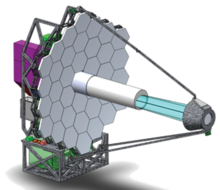This list contains proposals for space telescopes, space-based (situated in space) astronomical observatories. It is a list of past and present space observatory plans, concepts, and proposals. For observatories in orbit, see list of space telescopes. Unlike that list, this one includes concepts and proposals that are unlikely ever to be launched, as they may have been cancelled or were only proposals.
Additional examples and non-space telescopes
For launch in the 2030s, NASA is evaluating four possible designs: the Origins Space Telescope, Lynx X-ray Surveyor, Habitable Exoplanet Imaging Mission (HabEx), and Large UV Optical Infrared Surveyor (LUVOIR).[28]
Balloon-borne telescopes have been in use since the 1950s. A 20–30 meter balloon telescope has been suggested.[29] The balloon would be transparent on one side, and have a circular reflecting mirror on the other side.[29] There are two main designs using this principle.[29]
- Large Balloon Reflector (LBR) (sub-orbital version)
- Space-based Large Balloon Reflector (LBR)
- TeraHertz Space Telescope (TST)[30]

